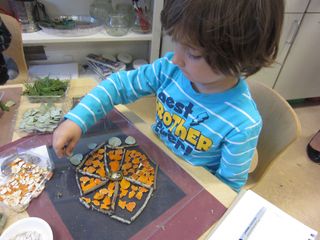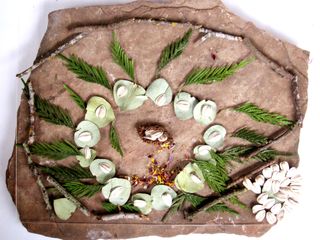Natural Materials Dialogue

"But too often and too quickly the leaves become leaf corpses far removed from the 'pulse of life' which ought not to be lost during the course of investigation, whether in drawing, natural sciences, or other."
A goal and expectation for Opal students is to "pay attention to nature as a mindful steward of the planet". Our experiences as teachers inform us that children are naturally drawn to the natural world and all of its' splendor and complexity. As such, we try to spend as much time as possible in nature throughout the school year. During these encounters it is inevitable that children will begin collecting special rocks, sticks, pinecones, leaves and more. These collections begin to come into the classroom and grow over time. It is always challenging to know what to do with these artifacts, if anything. We began to wonder…
What might we do with these natural materials?
Where could we look for inspiration of uses of natural materials?
We have often been inspired by the art work of Andy Goldsworthy and wondered if this could provide some inspiration for us to consider ways to use these natural materials. We have also seen work done by children in the schools of Reggio Emilia that used natural materials in interesting ways and in new forms.
We invited the children and families to add to our collections. As the collections grew we continued to wonder…
What happens when we offer children opportunities to transform materials from nature? What do they notice as "they breathe new life" into them? What are they drawn to?
Children embraced this idea of transforming the natural materials by using all of their senses.
As they pound, shred, sift these materials, their attention is drawn to the new forms and smells that emerge. These thrilling discoveries respond to children’s inborn desire to understand, shape and influence their world and all the pieces within it. It also responds to their desire to be shaped and influenced by experiences and things in their world, through this relationship with materials as they begin to see themselves as generators and contributors of new “powders, smells, colors, designs!” 


It is also through this role that they begin their journey of understanding and making meaning of the concept of transformation. By manipulating the materials, they have a concrete, tangible and engaging experience with this idea of transformation, both as witness to how materials transform, but also, as doer, the transformer. We believe that these ideas are imperative for children to explore and understand and offer us a beautiful analogy to how a community is created.
As the materials began to transform we wondered…
"What might we do with these materials? How will these materials when offered as another "language" be different from other "languages" such as, paint, clay, and pens?"
Children have begun to create compositions using a wide palette of natural materials. As teacher-researchers, why do we think that this is an important part of the process? What might be going on?
In reflection, it could be easy to see these encounters in the natural world as "just play" or as a string of experiences as we venture with the children on hikes, collecting leaves, having leaf fights, jumping in leaf piles, using some for fairy houses, and bringing these leaves back to the classroom for sorting by color. However, there are many layers of meaning and intention behind these experiences.  We invite children to use their hands, sieves, mortar and pestles, scissors and other tools to transform these leaves into a variety of sizes of crumbled leaves and powder. They are then invited to play with these materials to “paint” compositions that use elements of design such as, line, color, shape, etc. We are surprised by the elegant designs, and by the energy and time children invest in each piece.
We invite children to use their hands, sieves, mortar and pestles, scissors and other tools to transform these leaves into a variety of sizes of crumbled leaves and powder. They are then invited to play with these materials to “paint” compositions that use elements of design such as, line, color, shape, etc. We are surprised by the elegant designs, and by the energy and time children invest in each piece.

Perhaps it is because the leaf "paints” hold much more meaning for the children than another art material that is provided to them, such as, clay, paint, pens and such. These natural materials hold memories, smells, and sounds. They hold connection to a child's imagination. 
We were also surprised by how readily the pieces, once completed were disassembled by the children. Perhaps the children think of these materials as friends. It is in each child's unique relationship with the materials that their composition reflects this connection. A child comes to know himself through these materials. In this way the relationship is transformed. So who or what was the transformer and who or what was transformed? In these experiences a child's empathy grows for the natural world. It is crucial for children to love the earth as they are the future decision-makers for how we care for our earth.












